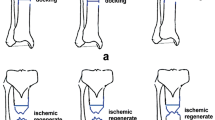Abstract
The technique of delayed autogenous cortical bone grafting was used in 17 patients (6 women, 11 men, with an average age of 22 years) to treat diaphyseal defects resulting mainly from closed or compound fractures complicated by infection and bone tissue loss. Bones affected were the humerus in 1 case, the radius in 7 cases, the ulna in 4 cases, the radius and ulna in 2 cases, the first metacarpal in 1 case, and the femur in 2 cases. The average length of the defect was 5.7 cm and the graft, prepared from the anteromedial aspec of the tibia, was at least 1.5 cm longer than the defect. The graft application was combined with rigid internal fixation using an AO 3.5 mm DCP plate in most cases and this permitted early active movement. Union occurred without the need for any additional grafting procedure in 14 patients and within an average of 23 weeks. In most cases there was an increase in the thickness of the graft probably as a result of osteo-induction, with consequent restoration of the original diameter of the recipient bone diaphysis. The most frequent complication was infection (4 cases), and this was controlled by means of debridement, cleaning and antibiotics. A delayed graft provides mechanical support, incorporates quickly and is therefore a reasonable alternative method for treating diaphyseal defects of long bones, particularly in the upper limb.
Résumé
La technique de l’autogreffe corticale retardée a été utilisée chez 17 patients (six femmes et onze hommes à l’âge moyen de 22 ans) pour traiter les pertes de substance osseuse diaphysaires, résultant surtout des fractures fermées ou ouvertes compliquées par l’infection et la perte d’os, du radius (7), cubitus (4), radius et cubitus (2), humérus (1), premier métacarpean (1) et femur (1). La longueur moyenne des fractures était de 5, 7 cm et la greffe a été preparée dans la face antéro-intérne de la tibia au moins 1, 5 cm plus longue que la fracture. L’application de la greffe a été faite par la fixation interne rigide avec une plaque DCP de 3, 5 mm dans la majorité de cas, ce qui a permis la mobilisation précoce. L’integration de la greffe s’est faite, sans qu’on fasse une nouvelle greffe, sur 14 patients, dans une période moyenne de 22, 9 semaines. Dans la majorité de cas, il y a eu une augmentation de l’épaisseur de la greffe peut-être comme résultat de l’ostéo-indution, avec la restauration conséquente du diamètre original de la diaphyse de l’os recepteur. La complication la plus fréquente a été l’infection (4 cas) controlée par le débridement, le nettoyage chirurgical et l’usage des antibiotiques. L’autogreffe retardée donne un support mécanique correct et est incorporé rapidement et c’est alors une alternative raisonnable pour le traitement des fractures diaphysaires des os longs, surtout des membres superieurs.
Similar content being viewed by others
Author information
Authors and Affiliations
Additional information
Accepted: 24 August 1999
Rights and permissions
About this article
Cite this article
Barbieri, C., Mazzer, N. & Mazer, M. Use of a delayed cortical bone graft to treat diaphyseal defects in the forearm. International Orthopaedics SICOT 23, 295–301 (1999). https://doi.org/10.1007/s002640050375
Issue Date:
DOI: https://doi.org/10.1007/s002640050375




